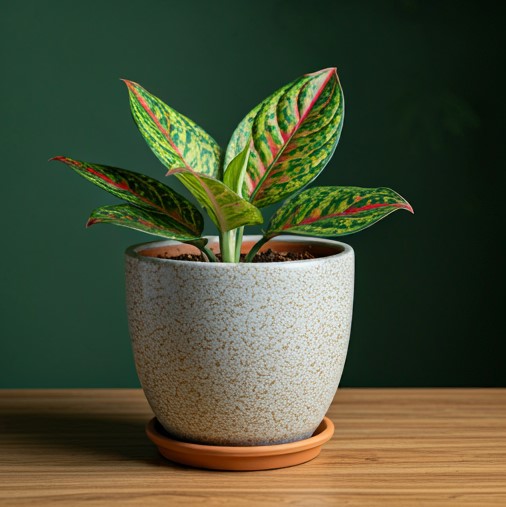
Aglaonema Chocolate is a charming houseplant featuring foliage that displays rich chocolate color and slight pink veins. This plant is one of the least common varieties in the Aglaonema genus, making it a favorite addition for plant collectors and indoor gardeners. Aglonema Chocolate is fabulous, but also a practical houseplant that is known for being low maintenance and a good houseplant for low-light environments. In this ultimate care guide, we go over everything from light and water to soil and pest-control in order to support this gorgeous variety in your own right.
1. More about Aglaonema Chocolate: The One-Of-A-Kind Type
Another reason why Aglaonema Chocolate is famous for its dark chocolate-like leaves with tiny pinks on the edges. It wear the looks but also the jewel, it really is good for those owners with time constraints or if you just want something pretty in your collection.
2. Best Place for an Aglaonema Chocolate
Grows in indirect light medium to low It is tolerant of lower light conditions but it brings out the colors much better with some filtered light. Do not put it in direct sun, since that will burn its leaves.
3. Watering Chocolate [Aglaonema]
The watering of Aglaonema chocolate plants is very important:
- Water once top inch of soil dried out.
- Prevention from waterlogging, use a pot with drainage holes
- Water less frequently when plants slow down with the cooler months.
4. Degree of Soil Preference for Aglaonema Chocolate
Well-draining soil mix is ideal for growing Aglaonema Chocolate. The perfect medium should be a mixture of potting soil, perlite, and peat moss to keep enough moisture in without being too wet. This is essential for developing good roots.
5. Aglaonema Chocolate Humidity Requirements
As a tropical plant Aglaonema Chocolate thrives in moderate to high humidity. In order to create an environment which is suitable:
- A humidifier (to keep humidity levels stable)
- Place it in a grouping with other plants to make a microclimate.
- Spray the leaves from time to time to keep them from drying out.
6. Aglaonema Chocolate Temperature Tolerance
Keep it between 65°F and 80°F (18°C–27°C) Keep the plant sheltered from drafts, sudden temperature fluctuations, and air conditioning vents to prevent stress on the plant and regular growth.
7. Fertilizing Aglaonema Chocolate to Boost Its Growth
Use a balanced liquid fertilizer every 4-6 weeks throughout the growing season (Spring and Summer). In autumn and winter months, feed sparingly to avoid over-feeding which can burn out the roots.
8. How To Prune And Shape Your Aglaonema Chocolate
Pruning your plant regularly maintains a tidy appearance and encourages new growth. With sanitized scissors, trim any dead, yellowed, or otherwise damaged leaves the plant may have as well to prevent disease and enhance the overall appearance of the plant.
9. Aglaonema Chocolate Re-Potting: When and How
You should repot your plant when its pot starts to feel too small. A good rule of thumb is every 1-2 years depending on the fastest of growth. Select a slightly larger pot with some fresh soil to allow the roots to grow. It also gets rid of accumulated nutrients in its soil and offer a reset to the plant.
10. How to Propagate Aglaonema Chocolate
One of the most satisfying methods to grow new plants from your existing Aglaonema Chocolate is propagating. The best ones you can do:
- Division: When repotting, gently separate the clumps of roots.
- For Stem cuttings: Insert cuttings in water or soil until they root.
11. Dealing With Common Pests Of Aglaonema Chocolate
Although Aglaonema Chocolate are relatively pest-resistant, they may sometimes be infested by:
Spider mites: Most notices by webbing on leaves.
– Mealybugs: Also looks like a white cotton-like mass on stems and leaves.
Aphids — tiny green or black insects that suck sap.
Apply neem oil or insecticidal soap for infestations and regularly wipe down the leaves to avoid pest issues.
12. Guide to Fixing Traditional Issues
Yellow Leaves: Leaves turning yellow are a sign of overwatering, lack of nutrients or poor drainage.
Brown Tips: Sign of low humidity or not enough water
Droopy Leaves: Lack of consistent watering or not enough light.
This is what how you can resolve these issues quickly and bring back the healthiness and its beauty of your plant.
13. Using Aglaonema Chocolate For Decoration
The dark, rich foliage of Aglaonema Chocolate makes it such a versatile decorative piece. Here are some ideas:
Plant it in ornamental containers: it has a unique style
This can be used as a centerpiece on tables or desktops.
Combine it with some other plants and you will have a hardy indoor rainforest.
14. Advantages of Chocolate Aglaonema
But Aglaonema Chocolate is also much appreciated for the following merits, in addition to the fact that it is a beautiful plant.
1] Air purification – Works as toxin removal from the air as well as improvement of room air quality.’
Easy-Care: Perfect for those who are always busy.
Versatile: Will do well under different indoor conditions, including low light gardens.
15. Aglaonema Chocolate Compared To Other Varieties
Aglaonema chocolate is a variety of this plant but Aglaonema Silver Bay or Aglaonema Red Siam look slightly different. Through comparing these varieties, you can comprehend which type is group to best snap off your fashion and area.
Conclusion: How to Take Care of Aglaonema Chocolate
Aglaonema Chocolate is one of the most beautiful varieties in the Aglaonema family, they are also beautiful as well as a good friend for you. Using these care tips included in this guide, you can keep your plant healthy and enjoy it as a long-term indoor garden eye-catcher. Aglaonema Chocolate is a distinctive and wonderful houseplant that makes an exotic and exciting treat for the home for the seasoned collector and growing novice alike. This rare breed will thrive under good maintenance, but will also bring joy and elegance into your home for many years.




